Pictured: An ancient redwood in Big Sur, CA (and me appreciating it).
about me (dinner table conversations)…
I am, to an extent, a product of the conversations at my dinner table: Growing up, my mother started conversations about the implications of our whiteness and her work as a leadership coach for KIPP, an organization that starts charter schools serving primarily low income students and students of color. My dad, a medical doctor, talked about his work trying to reduce burnout among his fellow physicians. I got a core belief from them: life is best spent in the service of others.
Although thousands of miles from my parents’ table, my dinner table is a place where another kind of family gathers to navigate values as we cook and eat together. I’m so grateful for my chosen family: my partner for her unconditional love and for activating my inner goofy child, my many friends (and my two siblings) who share my commitment to centering their work on equity, social justice, and sustainability in a myriad of ways, and to my community of other gender queer folks who have provided love and support as I explore my own identities.
my path to human-centered design (twists and turns)…
It was absurdly lucky that my suburban town happened to house one of the world's most successful high-school robotics teams. My experience in competitive robotics taught me a lot about project management, leadership, and professional communication… not to mention software engineering. I very nearly went to engineering school, but was persuaded at the last minute to try liberal arts instead, which turned out to be the right decision, because I’m happiest when constantly learning new things. For my first several terms at Dartmouth, I imagined that being an environmental engineer might allow me to use the engineering skills I enjoyed while doing something good for the world. I took environmental studies courses in the social sciences – reading Emerson and discussing nature-culture interactions and environmental justice. I also took an environmental modeling course, and spent a summer working for the California Energy Commission: While there were aspects of it that I liked, I realized that overall it wasn’t for me. I was just beginning to come to terms with that reality when I took a course called Introduction to Design Thinking.
Over time, I fell in love with this strange discipline: its creative processes celebrate my inner silly-creative child, and yet it’s versatile enough that I’m always learning; it’s analytical enough to satisfy the analytical part of my brain that I learned to love as an engineer yet it explicitly makes space to consider the emotional human factors, leveraging the social sciences side of my brain and education. Unfortunately, human-centered design has historically been used primarily by companies as a means to make more profitable products. However, I count myself among a growing movement of folks using human-centered design explicitly make the world a better place.
rumble strips…
I think of the shoulder rumble strip (that little bumpy part on the edge of most highways) as a paragon of Human-Centered Design. It’s simple and feels like it should've always been there, and it saves many lives every day. It’s my dream to someday design something as brilliant as this.
what I’m doing now (other than HCD)
Learning SO much about regenerative agriculture, and the deep connections between our food systems, climate change, and equity. Gardening at home and often working part time on farms.
Enjoying the outdoors: Hiking, maintaining trails, XC skiing … Occasionally doing live re-enactments of that old iPhone game “Fruit Ninja,” throwing rotting fruit at one another and chopping it out of the air with a sword
Writing and recording songs
Reading lots
Lots of other odd things … I guess you’ll have to get to know me ;)
